Simon Benninga. Financial Modelling 3-rd edition
Подождите немного. Документ загружается.

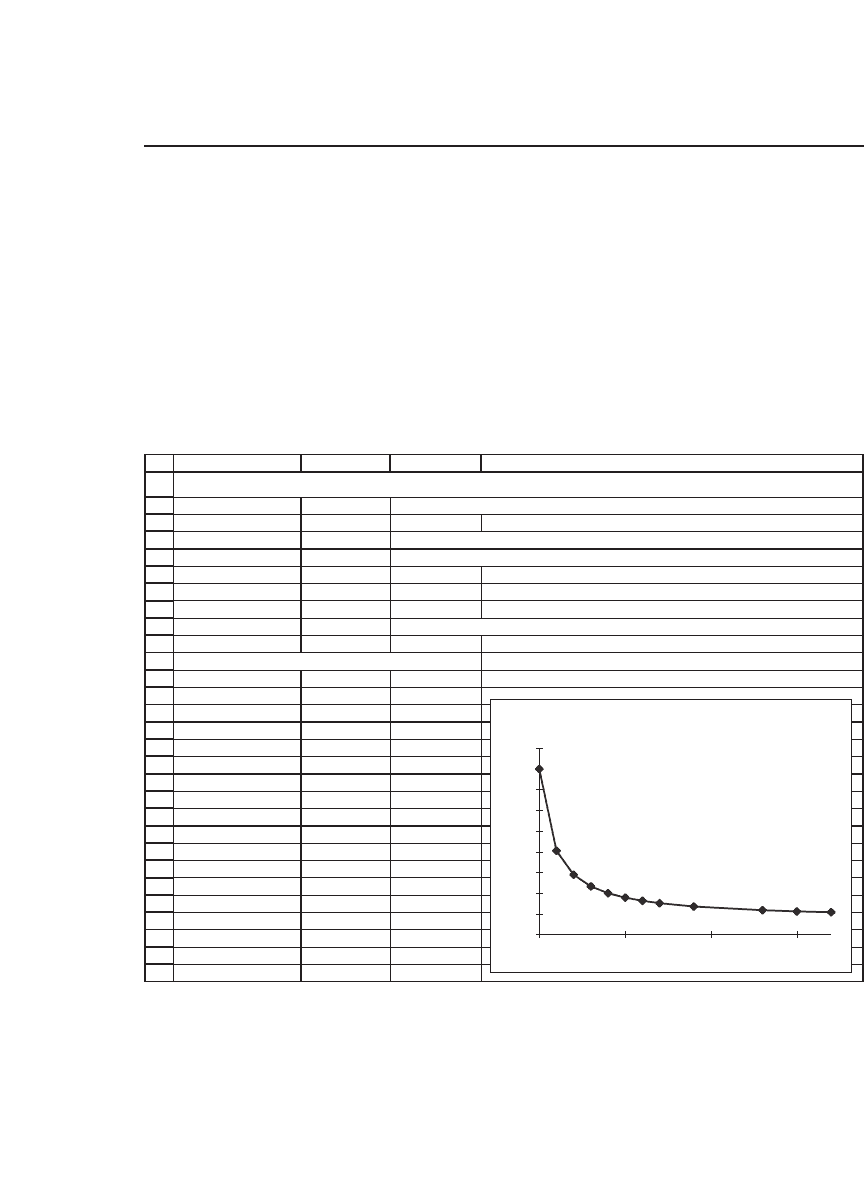
678 Chapter 25
25.4 Duration Patterns
Intuitively we would expect duration to be a decreasing function of a
bond’s coupon and an increasing function of a bond’s maturity. The fi rst
of these intuitions is correct, but the second is not.
The following spreadsheet shows the effect of increasing the coupon
on a bond’s duration, which—as our intuition indicated—indeed declines
as the coupon increases:
1
2
3
4
5
6
7
8
9
10
11
12
13
14
15
16
17
18
19
20
21
22
23
24
25
26
27
28
29
ABC D
Current date 5/21/1996 <
--
=DATE(1996,5,21)
Maturity, in years 21
Maturity date 5/21/2017 <
--
=DATE(1996+B3,5,21)
YTM 15% Yield to maturity (i.e., discount rate)
Coupon 4%
Face value 1,000
Duration 9.0110 <
--
=DURATION(B2,B4,B6,B5,1)
Data table: Effect of coupon on duration
9.0110 <
--
=B9 , data table header
0% 21.0000
1% 13.1204
Bond coupon
--
> 2% 10.7865
3% 9.6677
4% 9.0110
5% 8.5792
6% 8.2736
7% 8.0459
9% 7.7294
13% 7.3707
15% 7.2593
17% 7.1729
EFFECT OF COUPON ON DURATION
Effect of Coupon on Duration
Maturity = 21, YTM = 15.00%
5
7
9
11
13
15
17
19
21
23
051015
Coupon rate (%)
Duration
It is not true, however, that the duration is always an increasing func-
tion of the bond maturity:
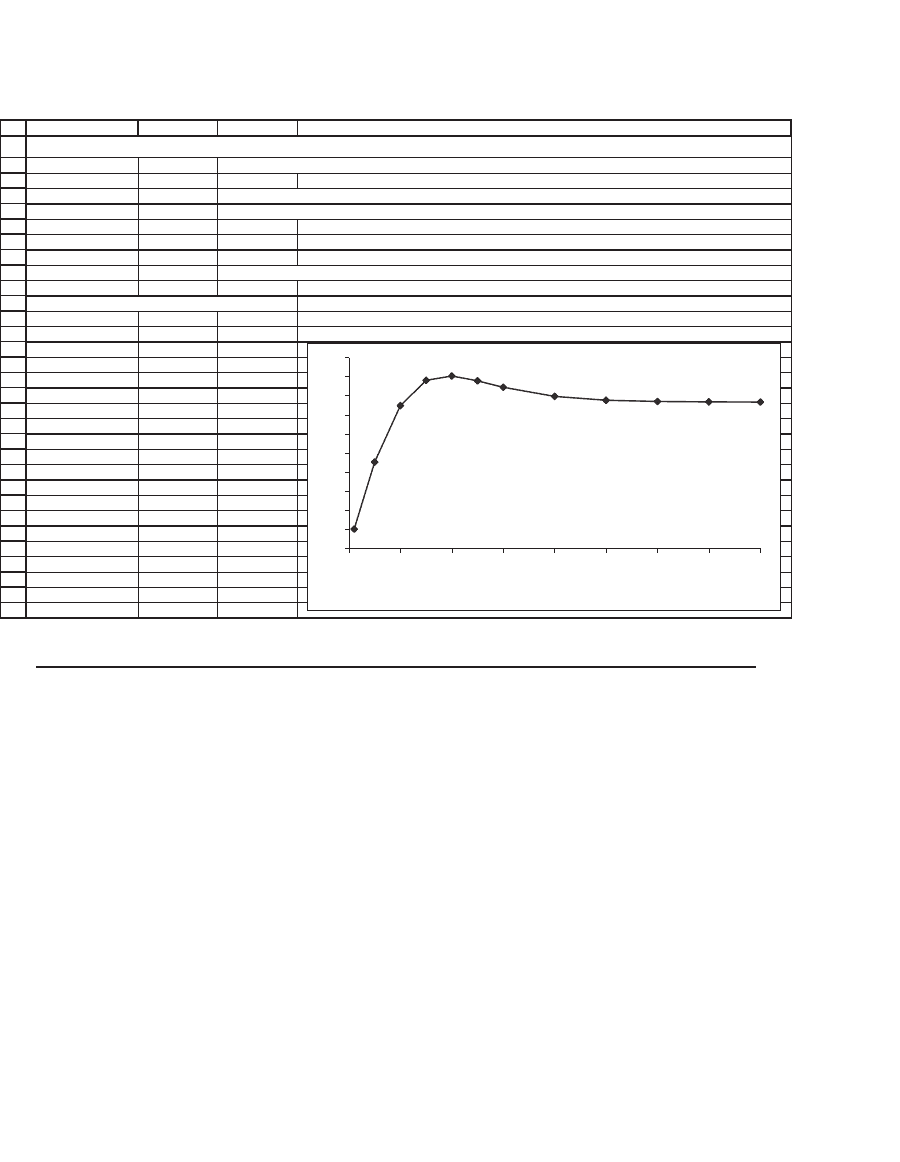
679 Duration
25.5 The Duration of a Bond with Uneven Payments
The duration formulas that we have discussed assume that bond pay-
ments are evenly spaced. This is almost invariably the case for bonds,
except for the fi rst payment. For example, consider a bond that pays inter-
est on May 1 of each of the years 1997, 1998, . . . , 2010, with repayment
of its face value on the last date. All the payments are spaced one year
apart; however, if this bond is purchased on September 1, 1996, then the
time to the fi rst payment is eight months, not one year. We shall refer to
such a bond as a bond with uneven payments. In this section we discuss
two aspects of this (extremely common) problem:
•
The calculation of the duration of such a bond, when the YTM is
known. We show that the duration has a very simple formula, related to
the duration of a bond with even payments (i.e., the standard duration
formula). In the process of the discussion we develop a simpler duration
formula in Excel.
1
2
3
4
5
6
7
8
9
10
11
12
13
14
15
16
17
18
19
20
21
22
23
24
25
26
27
28
29
30
31
ABC D
Current date 5/21/1996 <
--
=DATE(1996,5,21)
Maturity, in years 21
Maturity date 5/21/2017 <
--
=DATE(1996+B3,5,21)
YTM 15% Yield to maturity (i.e., discount rate)
Coupon 4%
Face value 1,000
Duration 9.0110 <
--
=DURATION(B2,B4,B6,B5,1)
Data table: Effect of maturity on duration
9.0110 <
--
=B9 , data table header
11.0000
54.5163
Bond maturity
--
>10 7.4827
15 8.8148
20 9.0398
25 8.7881
30 8.4461
40 7.9669
50 7.7668
60 7.6977
70 7.6759
80 7.6693
EFFECT OF MATURITY ON DURATION
Effect of Coupon on Duration
Coupon rate = 4.0%, YTM = 15.00%
0
1
2
3
4
5
6
7
8
9
10
0 1020304050607080
Maturity
Duration

680 Chapter 25
•
The calculation of the YTM of a bond with uneven payments. This
requires a bit of trickery, and ultimately leads us to another VBA
function.
25.5.1 Duration of a Bond with Uneven Payments
Consider a bond with N payments, the fi rst of which occurs at time α <
1, and the rest of which are evenly spaced. In the derivation that follows
we show that the duration of such a bond is given by the sum of two
terms:
•
The duration of a bond with N payments spaced at even intervals (i.e.,
the standard duration discussed previously).
•
α − 1
The derivation is relatively simple. Denote the payments on the bond
by C
α
, C
α+1
, C
α+2
, . . . , C
α+N−1
, where 0 < α < 1. The price of the bond is
given by
P
C
r
r
C
r
t
N
t
t
t
N
t
t
=
+
=+
+
=
+−
+−
−
=
+−
∑∑
1
1
1
1
1
1
1
1
1
α
α
α
α
()
()
()
The duration of this bond is given by
D
P
tC
r
t
N
t
t
=
+−
+
=
+−
+−
∑
11
1
1
1
1
()
()
α
α
α
Rewrite this last expression as follows:
D
P
r
tC
r
C
r
t
N
t
t
t
N
t
t
=+
+
+
−
+
⎧
⎨
⎩
⎫
⎬
−
=
+−
=
+−
∑∑
1
1
1
1
1
1
1
1
1
1
()
()
()
()
α
αα
α
⎭⎭
=
+
+
+
+
+
−
=
+−
−
=
+−
∑
∑
1
1
1
1
1
1
1
1
1
1
1
()
()
()
()
(
r
C
r
r
tC
r
t
N
t
t
t
N
t
t
α
α
α
α
α −−
+
⎧
⎨
⎩
⎫
⎬
⎭
=
+
=
+−
=
+−
=
+−
∑
∑
∑
1
1
1
1
1
1
1
1
1
1
)
()
()
t
N
t
t
t
N
t
t
t
N
t
C
r
C
r
tC
α
α
α
(()1
1
+
⎧
⎨
⎩
⎫
⎬
⎭
+−
r
t
α
Here is an example of the calculation of the duration of a bond with
uneven periods. Recall that when there is α until the fi rst payment, the
duration formula is given by
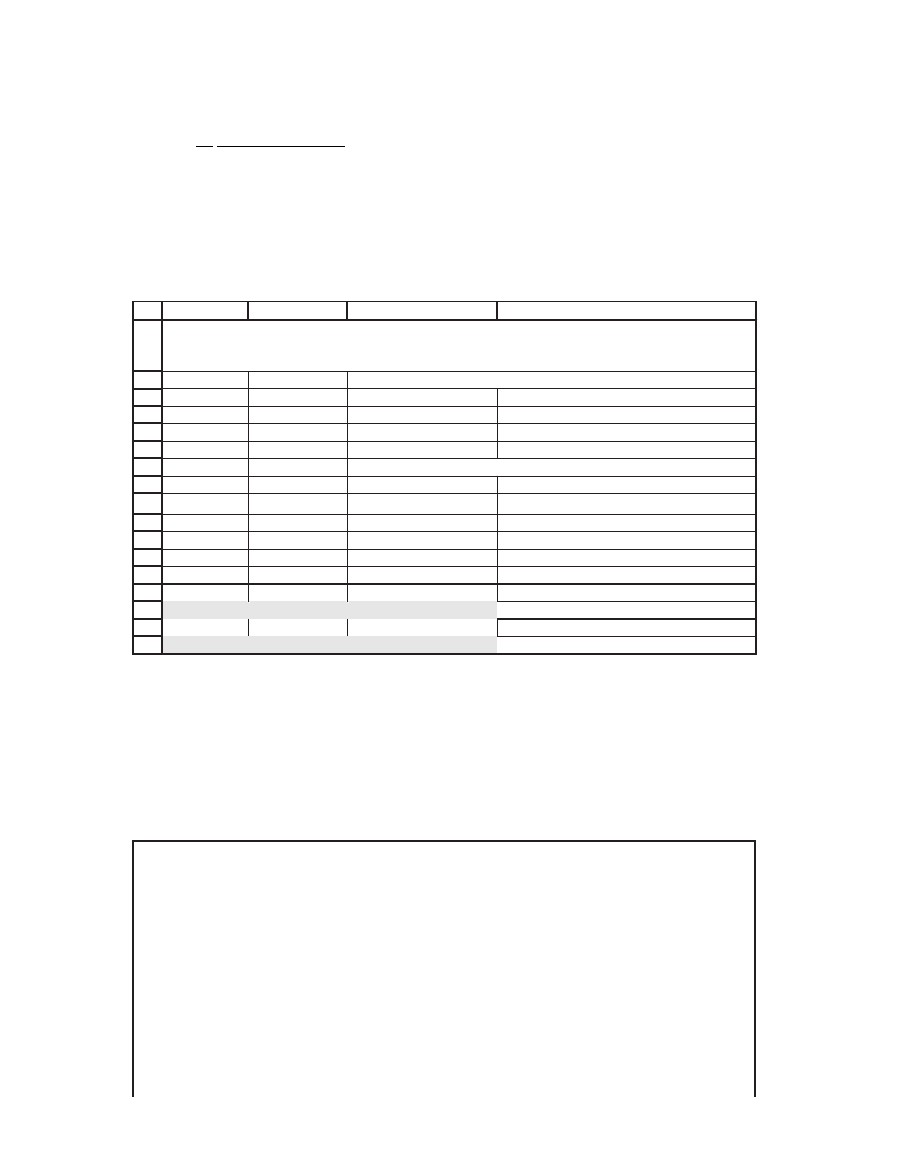
681 Duration
D
P
tC
r
t
N
t
t
=
+−
+
=
+−
+−
∑
1
1
1
11
1
()
()
α
α
α
Here is an example of the calculation of the duration of a bond with
uneven periods. Each of the cells D10:D14 calculates the value of a term
of this formula:
1
2
3
4
5
6
7
8
9
10
11
12
13
14
15
16
17
AB C D
Alpha 0.3 Time until first coupon payment (in years)
N 5 Number of payments
YTM 6%
Coupon 100
Face 1,000
Bond price 1,217 <
--
=NPV(B4,B10:B14)*(1+B4)^(1-B2)
Period Payment t*C
t
/Price*(1+YTM)
t
0.3 100 0.0242 <
--
=(B10*A10)/(1+$B$4)^A10/$B$7
1.3 100 0.0990
2.3 100 0.1653
3.3 100 0.2237
4.3 1,100 3.0249
Duration 3.5371 <
--
=SUM(C10:C14)
Newly defined VBA function 3.5371 <
--
=dduration(B3,B5/B6,B4,B2)
DURATION OF BOND WITH UNEVEN PERIODS
Brute Force Calculation and Dduration function
As noted in section 25.2.1, the built-in Excel formula Duration( )
is somewhat diffi cult to use, because of the insertion of the dates. We
therefore write a simpler duration formula using VBA; the syntax of this
formula is DDuration(numPayments, couponRate, YTM, timeFirst):
Function dduration(numPayments, couponRate,
YTM, timeFirst)
price = 1 / (1 + YTM) ^ numPayments
dduration = numPayments / (1 + YTM) ^ _
numPayments
For Index = 1 To numPayments
price = couponRate / (1 + YTM) ^ _
Index + price
Next Index

682 Chapter 25
Our homemade formula DDuration requires only the number of pay-
ments on the bond, the coupon rate, and the time to the fi rst payment α.
The use of the formula is illustrated in the previous spreadsheet picture,
in cell C17.
25.5.2 Calculating the YTM for Uneven Periods
As the preceding discussion shows, the calculation of duration requires
us to know the bond’s yield to maturity (YTM); this YTM is just the
internal rate of return of the bond’s payments and its initial price. Often
the YTM is given, but when it is not, we cannot use Excel’s IRR function
but must instead use the XIRR function.
Consider a bond that currently costs $1,123 and that pays a coupon of
$89 on January 1 of each year. On January 1, 2001, the bond will pay
$1,089, the sum of its annual coupon and its face value. The current date
is October 3, 1996. The problem in fi nding the YTM of this bond is that
while most of the bond payments are spaced one year apart, there is only
0.2466 of a year until the fi rst coupon payment: 0.2466 = [Date(1997,1,1)
− Date(1996,10,3)/365]. Thus we wish to use Excel to solve the following
equation:
−+
+
+
+
=
=
+
∑
1
89
1
1
0
0
3
0 2466 4 2466
,123
,089
(1
t
t
YTM YTM() )
..
To solve this problem, we can use the Excel function XIRR:
For Index = 1 To numPayments
dduration = couponRate * Index / _
(1 + YTM) ^ Index + dduration
Next Index
dduration = dduration / price + timeFirst
- 1
End Function
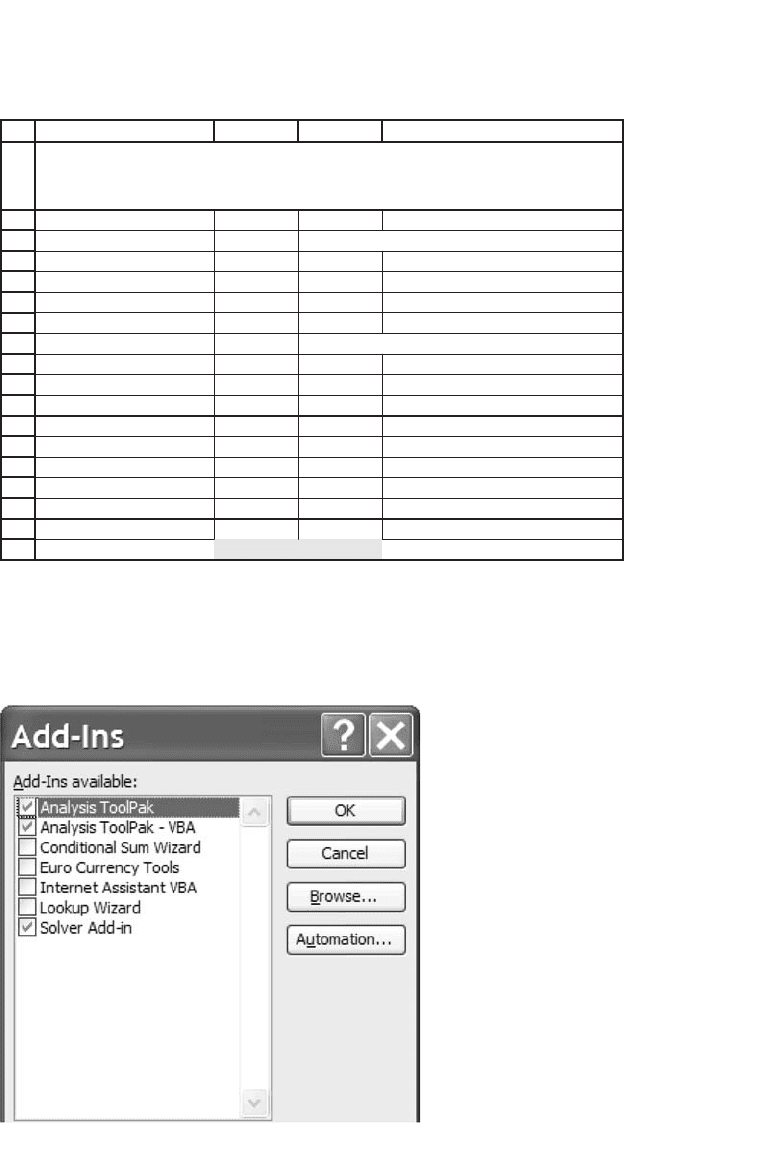
683 Duration
To use the XIRR function, you fi rst have to make sure that the Analy-
sis ToolPak is loaded into Excel. Go to Tools|Add-Ins. This brings up the
following menu, in which you have to make sure that Analysis ToolPak
is checked:
1
2
3
4
5
6
7
8
9
10
11
12
13
14
15
16
17
18
ABC D
Current date 3-Oct-96
Annual coupon 89 Paid January 1 for each of next 5 years
Maturity date 1-Jan-01
Face value 1,000
Price of bond 1,123
Time to first payment 0.2466 <
--
=(B12-B11)/365
Date Payment
3-Oct-96 -1,123
1-Jan-97 89
1-Jan-98 89
1-Jan-99 89
1-Jan-00 89
1-Jan-01 1,089
YTM 7.300% <
--
=XIRR(C11:C16,B11:B16)
USING XIRR TO CALCULATE THE IRR WITH
UNEVEN PAYMENTS

684 Chapter 25
You can now use XIRR, which returns the internal rate of return for
a schedule of cash fl ows that is not necessarily periodic. To use this func-
tion you have to specify the list of cash fl ows and the list of dates. As in
the case of the Excel function IRR, you can also provide a guess for the
IRR, although this may be left out.
1
25.5.3 Calculating the YTM for Uneven Payments Using a VBA Program
If you do not know the payment dates, you can use VBA to calculate
the YTM for a series of uneven payments. The following program is
composed of two functions. The fi rst function, annuityvalue, calculates
the value
t
N
t
r
=
∑
+
1
1
1()
. The second function, unevenYTM, uses the simple
bisection technique to calculate the YTM of a series of uneven payments,
leaving you to choose the accuracy epsilon of the desired result.
1. There is also a function XNPV for fi nding the present value of a series of payments
made at uneven dates. This function is discussed in Chapter 34.
Function annuityvalue(interest, numberPeriods)
annuityvalue = 0
For Index = 1 To numberPeriods
annuityvalue = annuityvalue + 1 / _
(1 + interest) ^ Index
Next Index
End Function
Function unevenYTM(couponRate, faceValue,
bondPrice, _
numberPayments, timeToFirstPayment, _
epsilon)
Dim YTM As Double
high = 1
low = 0

685 Duration
An illustration of the use of this function follows:
While Abs(annuityvalue(YTM, numberPayments) _
* couponRate * _
faceValue + faceValue / (1 + YTM) ^
numberPayments - _
bondPrice / (1 + YTM) ^ (1 - _
timeToFirstPayment)) >= epsilon
YTM = (high + low) / 2
If annuityvalue(YTM, numberPayments) _
* couponRate * _
faceValue + faceValue / (1 + YTM) ^ _
numberPayments - _
bondPrice / (1 + YTM) ^ (1 - _
timeToFirstPayment) > 0 Then _
low = YTM
Else
high = YTM
End If
Wend
unevenYTM = (high + low) / 2
End Function
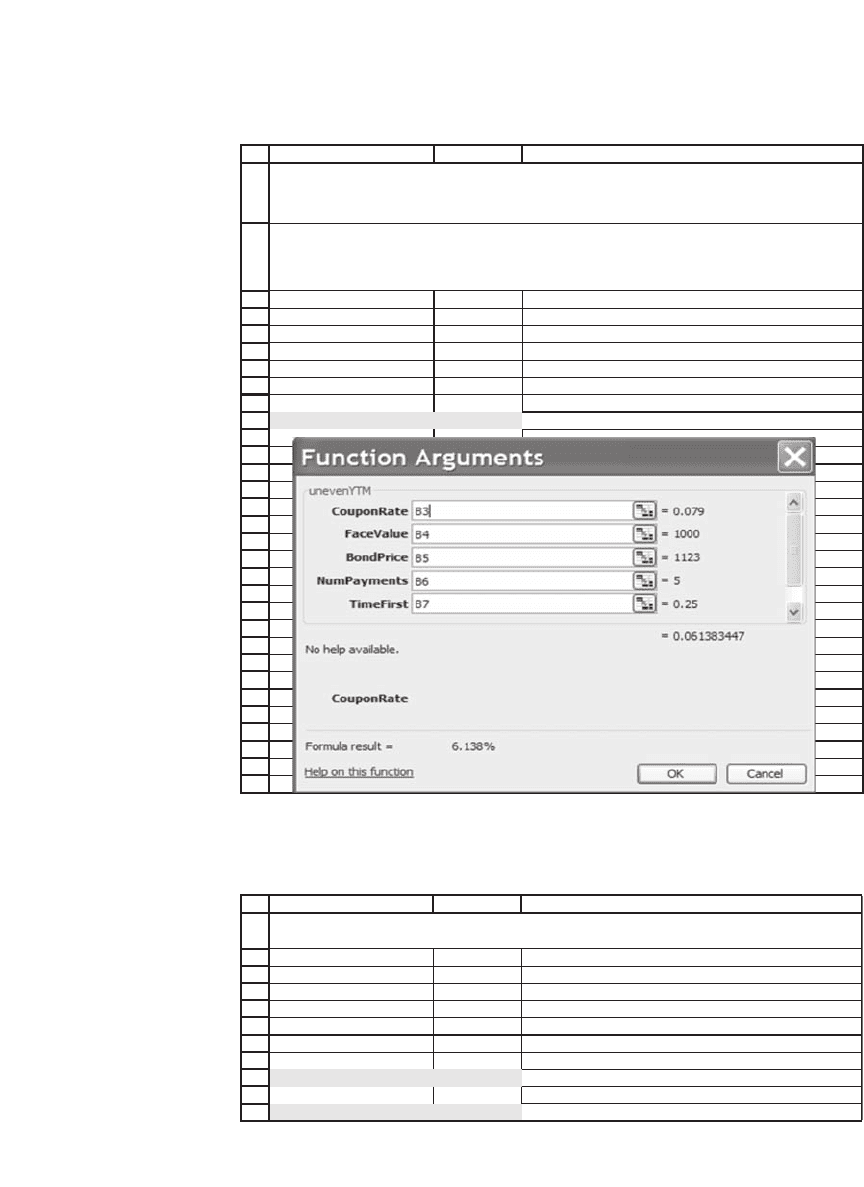
686 Chapter 25
1
2
3
4
5
6
7
8
9
10
11
12
13
14
15
16
17
18
19
20
21
22
23
24
25
26
27
28
29
30
31
AB C
Coupon rate 7.90%
Face value 1,000.00
Bond price 1,123.00
Number of payments 5
Time to first payment 0.25
Epsilon 0.00001 <
--
Controls the accuracy of the YTM calculation
YTM 6.138% <
--
=unevenYTM(B3,B4,B5,B6,B7,B8)
This spreadsheet illustrates the
unevenYTM
VBA function:
The syntax of this function is
unevenYTM
(CouponRate,FaceValue,BondPrice,NumPayments,TimeFirst,epsilon)
ILLUSTRATION OF CALCULATION
OF YTM OF UNEVEN PERIODS
We can, of course, use the Dduration function in conjunction with
unevenYTM to compute the duration:
1
2
3
4
5
6
7
8
9
10
11
AB C
Coupon rate 7.90%
Face value 1,000.00
Bond price 1,123.00
Number of payments 5
Time to first payment 0.25
Epsilon 0.00001 <
--
Controls the accuracy of the YTM calculation
YTM 6.138% <
--
=unevenYTM(B2,B3,B4,B5,B6,B7)
Duration 3.5959 <
--
=dduration(B5,B2,B9,B6)
USING DDURATION AND UNEVENYTM TOGETHER

687 Duration
25.6 Nonfl at Term Structures and Duration
In a general model of the term structure, payments at time t are dis-
counted by rate r
t
, so that the value of a bond is given by
P
C
r
t
N
t
t
t
=
+
=
∑
1
1()
The duration measure discussed in this chapter assumes either a fl at term
structure (i.e., r
t
= r for all t) or a term structure that shifts in a parallel
fashion. When the term structure exhibits parallel shifts, we can write the
bond price as
P
C
rt
t
N
t
t
t
=
++
=
∑
1
1()Δ
and then derive a measure of duration by taking the derivative with
respect to Δt.
A general model of the term structure should explain how the discount
rate r
t
for time-t payments comes about and how the rates at time t
change. This is a diffi cult problem, one aspect of which we discuss in
Chapter 28. A somewhat simpler problem, discussed in Chapter 27, is the
construction of a polynomial approximation to the term structure.
Does the diffi culty of the problem mean that the simple duration
measure we present in this chapter is useless? Not necessarily. It may be
that the Macauley duration measure gives a good approximation for
changes in bond value as a result of changes in the term structure, even
for the case when the term structure itself is relatively complex and not
fl at.
2
In this section, we explore this possibility, using data from the fi le
McCulloch_term_structures.xls, which is on the disk that accompanies
this book.
3
The fi le contains monthly information on the term structure
of interest rates in the United States for the period 12.1946–2.87 (i.e.,
December 1946–February 1987). A typical row of this fi le looks like
this:
2. A paper by Gultekin and Rogalski (1984) seems to confi rm that it does.
3. The data are from McCulloch (1990). A second fi le on the disk with this book, Daily
treasury yields, 1961–2006.xls gives the daily term structures.
